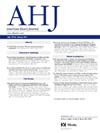感染性心内膜炎和收入作为社会经济地位的代理——丹麦全国基于登记的队列研究。
IF 3.7
2区 医学
Q1 CARDIAC & CARDIOVASCULAR SYSTEMS
引用次数: 0
摘要
目的:尽管持续关注感染性心内膜炎,但发病率和死亡率仍然很高。已知社会经济地位会影响多种疾病的风险,但对感染性心内膜炎发生的影响尚不清楚。我们的目的是在未选择的全国人口中调查可用收入(代表社会经济地位)与感染性心内膜炎之间的关系。方法和结果:通过交叉链接丹麦全国登记册,我们确定了2007年1月1日至2017年12月31日期间所有30岁以上的丹麦居民。通过登记获得有关收入、合并症和感染性心内膜炎主要结局的信息。社会经济地位是根据可支配收入的五分之一来定义的。社会经济地位与感染性心内膜炎之间的关系采用多元泊松回归分析,结合可支配收入的时间更新估计。该研究包括3,524,314人(中位年龄 = 47岁),中位随访时间为11年。收入水平的下降与感染性心内膜炎发病率的增加有关,从7-20例/10万人年不等。低收入人群感染性心内膜炎的发病率比(IRR)高于高收入人群(最低与最高收入组,IRR = 1.58[1.43-1.75])。收入减少与感染性心内膜炎的IRR增加之间的关联存在于所有年龄组,尽管这种关联在年轻人群中最强。结论:在全国范围内,低收入与感染性心内膜炎发病率增加之间存在显著关联。这种关联在年轻人中最为明显。本文章由计算机程序翻译,如有差异,请以英文原文为准。
Infective endocarditis and the association to income as a proxy for socioeconomic position: A Danish nationwide register-based cohort study
Background
Despite continued focus on infective endocarditis morbidity and mortality remains high. Socioeconomic position is known to influence the risk of multiple diseases but the impact on the occurrence of infective endocarditis is unknown. We aimed to investigate the association between available income as a proxy for socioeconomic position and infective endocarditis in an unselected nationwide population.
Methods
By cross-linking Danish nationwide registers, we identified all Danish residents above 30 years of age, from January 1, 2007 through December 31, 2017. Information on income, comorbidities and the primary outcome of infective endocarditis was obtained through the registers. Socioeconomic position was defined according to quintiles of disposable income. The association between socioeconomic position and infective endocarditis was examined using multivariate Poisson Regression analyses, incorporating time-updated estimates of disposable income.
Results
The study included 3,524,314 individuals (median age = 47 years) with a median follow-up of 11 years. Declining level of income was associated with increasing incidence rates of infective endocarditis, spanning from 7 to 20 events/100,000 person-years. Individuals with low income had higher incidence rate ratio (IRR) of infective endocarditis compared to individuals with high income (lowest vs highest income group, IRR = 1.58 [1.43-1.75]). The association between decreasing income and increasing IRR of infective endocarditis was present across all age groups, although the association was strongest in the young population.
Conclusion
In a nationwide population, a significant association between low income and increasing incidence of infective endocarditis was observed. The association was most evident in younger individuals.
求助全文
通过发布文献求助,成功后即可免费获取论文全文。
去求助
来源期刊

American heart journal
医学-心血管系统
CiteScore
8.20
自引率
2.10%
发文量
214
审稿时长
38 days
期刊介绍:
The American Heart Journal will consider for publication suitable articles on topics pertaining to the broad discipline of cardiovascular disease. Our goal is to provide the reader primary investigation, scholarly review, and opinion concerning the practice of cardiovascular medicine. We especially encourage submission of 3 types of reports that are not frequently seen in cardiovascular journals: negative clinical studies, reports on study designs, and studies involving the organization of medical care. The Journal does not accept individual case reports or original articles involving bench laboratory or animal research.
 求助内容:
求助内容: 应助结果提醒方式:
应助结果提醒方式:


